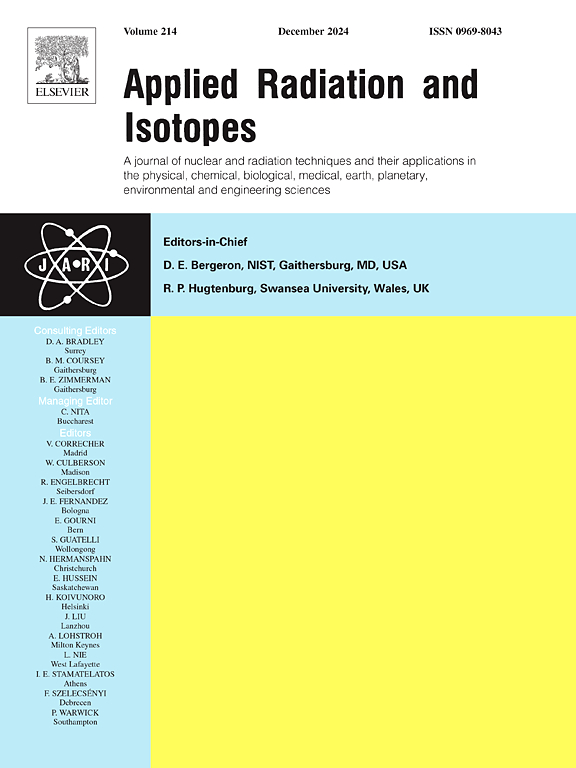尼日利亚拉各斯州 Ikorodu 轴心地区水中致癌氡含量的综合调查。
IF 1.6
3区 工程技术
Q3 CHEMISTRY, INORGANIC & NUCLEAR
引用次数: 0
摘要
本研究使用 RAD-7 检测器对拉各斯州伊科罗杜市两所高等院校收集的 20 份样本中饮用水的氡浓度进行了调查。目的是评估与氡接触相关的健康风险,氡是一种已知的致癌物质,与肺癌和胃癌有关。饮用水中的氡每年导致约 168 人死于癌症,主要是由于吸入室内释放的氡而导致肺癌,以及由于摄入受污染的水而导致胃癌。测得的氡浓度范围为 4.5 ± 1.1 Bq/m³ 到 25.5 ± 2.1 Bq/m³,其中 70% 的样本超过了美国环保局规定的最高污染水平 11.1 Bq/L。尽管氡含量很高,但每年摄入和吸入的有效剂量从 0.4545 到 24.37 μSv/y 不等,仍低于全球平均值 300 μSv/y 和世界卫生组织的限值 100 μSv/y。虽然伊科罗杜水源中存在氡表明存在放射性风险,但根据国际标准,相关的健康风险相对较低。这些发现强调了持续监测和潜在缓解措施的重要性,以确保该地区饮用水的持续安全。本文章由计算机程序翻译,如有差异,请以英文原文为准。
Comprehensive investigation of carcinogenic radon levels in water within the Ikorodu axis of Lagos State, Nigeria
This study investigates radon concentration in drinking water from twenty samples collected at two tertiary Institutions in Ikorodu, Lagos State, using the RAD-7 detector. The objective is to evaluate the health risks associated with radon exposure, a known carcinogen linked to lung and stomach cancer. Radon in drinking water contributes to approximately 168 cancer deaths annually, predominantly from lung cancer due to inhalation of radon released indoors and stomach cancer from ingesting contaminated water. The measured radon concentrations ranged from 4.5 ± 1.1 Bq/m³ to 25.5 ± 2.1 Bq/m³, with 70% of samples exceeding the EPA's maximum contamination level of 11.1 Bq/L. Despite these high levels, the annual effective doses from ingestion and inhalation varied from 0.4545 to 24.37 μSv/y, remaining below the global average of 300 μSv/y and WHO limit of 100 μSv/y. While the presence of radon in Ikorodu's water sources indicates a radiological risk, the associated health risks are comparatively low according to international standards. These findings underscore the importance of ongoing monitoring and potential mitigation measures to ensure the continued safety of drinking water in the region.
求助全文
通过发布文献求助,成功后即可免费获取论文全文。
去求助
来源期刊

Applied Radiation and Isotopes
工程技术-核科学技术
CiteScore
3.00
自引率
12.50%
发文量
406
审稿时长
13.5 months
期刊介绍:
Applied Radiation and Isotopes provides a high quality medium for the publication of substantial, original and scientific and technological papers on the development and peaceful application of nuclear, radiation and radionuclide techniques in chemistry, physics, biochemistry, biology, medicine, security, engineering and in the earth, planetary and environmental sciences, all including dosimetry. Nuclear techniques are defined in the broadest sense and both experimental and theoretical papers are welcome. They include the development and use of α- and β-particles, X-rays and γ-rays, neutrons and other nuclear particles and radiations from all sources, including radionuclides, synchrotron sources, cyclotrons and reactors and from the natural environment.
The journal aims to publish papers with significance to an international audience, containing substantial novelty and scientific impact. The Editors reserve the rights to reject, with or without external review, papers that do not meet these criteria.
Papers dealing with radiation processing, i.e., where radiation is used to bring about a biological, chemical or physical change in a material, should be directed to our sister journal Radiation Physics and Chemistry.
 求助内容:
求助内容: 应助结果提醒方式:
应助结果提醒方式:


